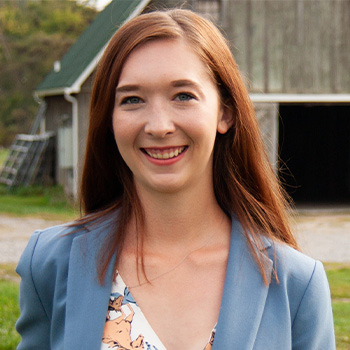Visiting Assistant Professor

Dr. Madison Barshick is a Visiting Assistant Professor for Animal Science. She obtained her B.S. in Animal Science and Biochemistry from Berry College in 2021 and her Ph.D. in Animal Science from Virginia Tech in 2025.
Her previous research endeavors focused on skeletal muscle’s response to exercise, utilizing both horses and mice as model organisms. Specifically, she was interested in the post-exercise recovery period, including the modulation of inflammation and response of skeletal muscle stem cells to damage. Additionally, she collaborates closely on other equine-related projects, including a study examining the pathogenesis of the bacterium responsible for Equine Strangles disease.
She aims to develop a research program focused on performance-limiting diseases in horses. Her interests include the pathogenesis of various bacterial diseases, including Equine Strangles and Thrush, skeletal muscle’s response to exercise following infections and nutritional interventions for improving equine performance.
Dr. Barshick has previous experience in undergraduate education, contributing to various upper-level Animal Science courses as both an instructor and guest speaker. Her interests include Exercise Physiology, Muscle Biology and Veterinary Microbiology.
Education
- Ph.D., Animal Science, Virginia Tech
- B.S., Animal Science and Biochemistry, Berry College
Teaching Interests
- Veterinary Microbiology
- Anatomy and Physiology
Research Interests
- Skeletal Muscle Biology
- Equine Performance
- Performance Limiting Diseases
- Infectious Diseases of the Horse
Selected Publications
- M.R. Barshick*, K.M. Ely, K.C. Mogge, L.M. Chance, and S.E. Johnson; ”Methylsulfonylmethane (MSM) supplementation to adult horses supports improved skeletal muscle inflammatory gene expression following exercise.”; Animals, 2025, 15, 215.
- J.W. Riley, L.M. Chance, M.R. Barshick*, and S.E. Johnson; “Administration of sodium hyaluronate to adult horses prior to and immediately after exercise does not alter range of motion in either the tarsus or metacarpophalangeal joints.”; Transl Anim Sci., 2024, 8:txae153.
- S.R. Gregg, M.R. Barshick*, and S.E. Johnson; “Intravenous Injection of Sodium Hyaluronate Diminishes Basal Inflammatory Gene Expression in Equine Skeletal Muscle.”; Animals 2023, 13, 3030.
- S.E. Johnson, M.R. Barshick*, M.L. Gonzalez, J.W. Riley, M.E. Pelletier, B.C. Castanho and E.N. Ealy; “A carnitine containing product improves aspects of post-exercise recovery in adult horses”; Animals, 2023, 13(4):657.
- M.R. Barshick*, M.L. Gonzalez, N.I. Busse, P.J. Helsel, and S.E. Johnson; "The initial delay to mitotic activity in primary cultures of equine satellite cells is reduced by combinations of growth factors”; J Anim Sci., 2022, 100, 8.
- D.V.L. Rhodes and M.R. Barshick*; "Adapting a Bacterial Unknowns Project to Online Learning: Using Microsoft PowerPoint to Create an Unknowns Identification Simulation”; J Microbiol Biol Educ., 2021, 22, 2.
Professional Associations
- American Society of Animal Science
- American Physiological Society
- American Society of Cell Biology
- American Society of Molecular Biology & Biochemistry